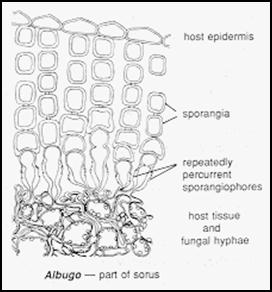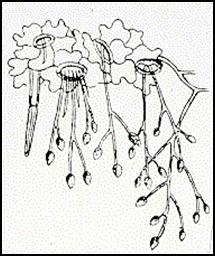

النبات

مواضيع عامة في علم النبات

الجذور - السيقان - الأوراق

النباتات الوعائية واللاوعائية

البذور (مغطاة البذور - عاريات البذور)

الطحالب

النباتات الطبية


الحيوان

مواضيع عامة في علم الحيوان

علم التشريح

التنوع الإحيائي

البايلوجيا الخلوية


الأحياء المجهرية

البكتيريا

الفطريات

الطفيليات

الفايروسات


علم الأمراض

الاورام

الامراض الوراثية

الامراض المناعية

الامراض المدارية

اضطرابات الدورة الدموية

مواضيع عامة في علم الامراض

الحشرات


التقانة الإحيائية

مواضيع عامة في التقانة الإحيائية


التقنية الحيوية المكروبية

التقنية الحيوية والميكروبات

الفعاليات الحيوية

وراثة الاحياء المجهرية

تصنيف الاحياء المجهرية

الاحياء المجهرية في الطبيعة

أيض الاجهاد

التقنية الحيوية والبيئة

التقنية الحيوية والطب

التقنية الحيوية والزراعة

التقنية الحيوية والصناعة

التقنية الحيوية والطاقة

البحار والطحالب الصغيرة

عزل البروتين

هندسة الجينات


التقنية الحياتية النانوية

مفاهيم التقنية الحيوية النانوية

التراكيب النانوية والمجاهر المستخدمة في رؤيتها

تصنيع وتخليق المواد النانوية

تطبيقات التقنية النانوية والحيوية النانوية

الرقائق والمتحسسات الحيوية

المصفوفات المجهرية وحاسوب الدنا

اللقاحات

البيئة والتلوث


علم الأجنة

اعضاء التكاثر وتشكل الاعراس

الاخصاب

التشطر

العصيبة وتشكل الجسيدات

تشكل اللواحق الجنينية

تكون المعيدة وظهور الطبقات الجنينية

مقدمة لعلم الاجنة


الأحياء الجزيئي

مواضيع عامة في الاحياء الجزيئي


علم وظائف الأعضاء


الغدد

مواضيع عامة في الغدد

الغدد الصم و هرموناتها

الجسم تحت السريري

الغدة النخامية

الغدة الكظرية

الغدة التناسلية

الغدة الدرقية والجار الدرقية

الغدة البنكرياسية

الغدة الصنوبرية

مواضيع عامة في علم وظائف الاعضاء

الخلية الحيوانية

الجهاز العصبي

أعضاء الحس

الجهاز العضلي

السوائل الجسمية

الجهاز الدوري والليمف

الجهاز التنفسي

الجهاز الهضمي

الجهاز البولي


المضادات الميكروبية

مواضيع عامة في المضادات الميكروبية

مضادات البكتيريا

مضادات الفطريات

مضادات الطفيليات

مضادات الفايروسات

علم الخلية

الوراثة

الأحياء العامة

المناعة

التحليلات المرضية

الكيمياء الحيوية

مواضيع متنوعة أخرى

الانزيمات
Phylum. Oomycota
المؤلف:
Kayser, F. H
المصدر:
almerja.com
الجزء والصفحة:
17-11-2015
3071
Phylum. Oomycota
Order: Peronosporales (Downy mildews)
This group contains the most advanced Oomycota. They are mostly obligate parasites on the aerial parts of higher plants. This order contains many destructive parasites of economic plants, and causes tremendous losses in crops each year. Since their spores are wind borne, their sporangia are not unspecialized hyphal tips, but borne on branched aerial asexual "sporangiophores", which produce asexual spores,There are also sexual sporangia borne on"sporangiaophores".
Albuginaceae:
Albugo candida:
Otherwise known as a "white rust" (cause White rust of crucifers) which produces whitish coloured blisters on the surface of its host. These blisters contain innumerable unicellular mitosporangia (sporangia that produce spores by mitosis) that develop in chains from the tips of short tightly packed sporangiophores . When the host epidermis bursts, the sporangia are wind- or rainsplash-dispersed to other host plants, where each can germinate to release eight biflagellate zoospores. Oogonia develop later, inside the host stem or leaves, and sexual reproduction is usually heterothallic.
 |
||||
|
|
||||

Pythiaceae:
Phytophthora infestans (the cause of late blight of potato).
The mycelium penetrates plant tissue, eventually killing it. This genus produces sporangium outside the plant( The lemon-shaped ,papillate sporangia are borne at the tips of the sporangiophore branches). The sporangia are held out from the surface of the plant by sporangiophore which grows through the stomata (small pore on leaf/stem surface). Several flagellate zoospores are produced within each sporangium. These zoospores are most effective in infecting other plants if transferred in wet conditions.
Peronosporaceae
Peronospora parasitica:
The fungus causing downy mildew in crucifers. the sporangiophores cover the surface of the leaves and stems of the infected plants, giving them a "downy" appearance.( the parasitized cells are not killed) . after few days of vegetative activity within the host, reproductive structures are formed. These are branched sporangiophore ,each emerges through a stoma and has an un branched lower region and a branched upper one with fine ends each bearing an oval sporangium.

Live Material
Saprolegnia
Place about a teaspoon of the mud in the bottom of a culture dish. Add sufficient water to cover the mud to a depth of one cm. Float some Sesame seeds on the surface and cover with plastic wrap to limit evaporation. Leave for one week. After a week, lift the Sesame seed and transfer to a clean petri dish. Add 10 ml of sterile
lake water to the petri and cover. Place in a dark cupboard for another week. Select seeds that have a mass of white "wool" growing out of them. Make a wet mount slide and examine for antheridia and oogonia.
 الاكثر قراءة في الفطريات
الاكثر قراءة في الفطريات
 اخر الاخبار
اخر الاخبار
اخبار العتبة العباسية المقدسة

الآخبار الصحية















 قسم الشؤون الفكرية يصدر كتاباً يوثق تاريخ السدانة في العتبة العباسية المقدسة
قسم الشؤون الفكرية يصدر كتاباً يوثق تاريخ السدانة في العتبة العباسية المقدسة "المهمة".. إصدار قصصي يوثّق القصص الفائزة في مسابقة فتوى الدفاع المقدسة للقصة القصيرة
"المهمة".. إصدار قصصي يوثّق القصص الفائزة في مسابقة فتوى الدفاع المقدسة للقصة القصيرة (نوافذ).. إصدار أدبي يوثق القصص الفائزة في مسابقة الإمام العسكري (عليه السلام)
(نوافذ).. إصدار أدبي يوثق القصص الفائزة في مسابقة الإمام العسكري (عليه السلام)


















